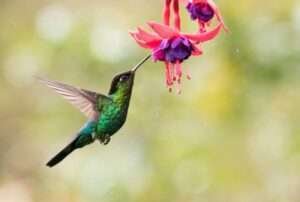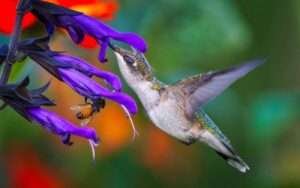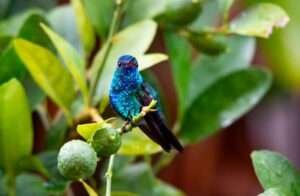
Overview of Hummingbirds and Their Need for Feeders
Here’s the ultimate resource for choosing the ideal hummingbird feeder: welcome! Our gardens are made more beautiful and joyful by these tiny, delicate animals. But did you realize that feeders are often essential to their survival? It is crucial to provide a steady food supply, particularly during migration or when there are few natural nectar sources. Whether you’re a novice or an experienced birdwatcher, this thorough guide will assist you in selecting the best hummingbird feeder for your feathered companions. Hummingbirds are unusual birds that enthrall us with their vivid feathers and swift flight. There are many chances to draw these fantastic birds to your yard because there are over 300 species in North and South America.
Let’s examine why hummingbirds depend so heavily on feeders before choosing the finest one. We can select a superior hummingbird feeder by knowing their unique feeding habits and dietary needs. So grab your binoculars and prepare for an exhilarating trip into the fascinating world of these tiny birds!
Advantages and Disadvantages
It’s essential to know the distinctions between different kinds of hummingbird feeders before selecting. Every variety has benefits and drawbacks.
Feeding ports are located at the base of a plastic or glass bottle in bottle feeders. Bird lovers love how simple it is to refill and clean them, but if the seal needs to be done right, they could leak.
Saucer feeders: Hummingbirds can perch on a clear saucer filled with nectar as they eat. These, though, might draw ants and other insects.
Tube feeders: These feeders imitate the form and position of flowers by placing feeding openings on the edges of tiny plastic tubes. They provide a more organic feeding experience, but because of their narrow shape, they can be challenging to clean.
Hanging baskets: Hanging baskets containing brightly cultured flowers that spontaneously release nectar can also draw hummingbirds. The drawback is that regular watering and trimming are necessary to keep these hanging arrangements in good condition.

Window-mounted feeders: These feeders, which use suction cups to connect to windows directly, are perfect for up-close inspections. Their close closeness to windows, nevertheless, might make bird collisions more likely.
The ideal hummingbird feeder for you will rely on your tastes and the requirements and habits of the hummingbird population in your area. You may need to experiment a little to find the ideal feeder, but with perseverance, you can make your backyard a warm and inviting refuge for these lovely birds.
Things to Think About When Choosing a Feeder
Feeder Size: Because hummingbirds have short beaks and tongues, choose feeders with tiny feeding ports, like those with narrow apertures, that complement their delicate features.
Feeder Material: Use sturdy materials like glass or plastic that are easy to clean and won’t rust or deteriorate over time. To keep unwanted pests away, think about using feeders with ant moats or bee guards.
Feeder Capacity: Select a feeder that can accommodate the hummingbird population in your area to satisfy their feeding requirements.
Feeder Location: Look for feeders with window mounting options or compact, space-saving designs if you have limited space or want to put the feeder next to windows for convenient observation.
Ease of Maintenance: Hummingbird feeders should be cleaned and refilled regularly to avoid mold formation and preserve the nectar. Choose a feeder that can be easily cleaned by removing pieces or having big mouth openings.
Increase your chances of drawing these beautiful birds to your backyard and create a more durable and easy haven by taking these factors into account when choosing your hummingbird feeder.
Top Hummingbird Feeders in Various Environments
When selecting the ideal hummingbird feeder, the surrounding conditions are a significant consideration. Choose feeders that can withstand shifting weather conditions to guarantee these tiny birds have a warm and secure area to flourish in various habitats and climates.
Hot, Dry Conditions: To prevent ants from getting to the nectar, choose feeders with built-in ant moats in desirable, dry locations.

Windy Areas: To avoid falling, consider feeders with sturdy construction and safe hanging mechanisms if you live in a windy location.
Wet Days: To avoid diluting nectar, choose feeders with rain guards or drip-proof components in places with regular rainfall.
Cold Areas: Choose feeders with insulation or heating components in colder areas to ensure hummingbirds may still obtain unfrozen nectar on frigid days.
Humid Climates: To avoid mold growth and keep insects out, choose feeders with efficient ventilation systems in humid environments.
No matter where you live, pick feeders with extended lifespans and less chance of weather or wildlife damage by selecting materials like glass or high-quality plastic.
By choosing the ideal feeder for your particular ecosystem, you may make a great feeding area for hummingbirds!
Strategies to Draw Hummingbirds to Your Feeder
Place Is Important: Decide where you want your hummingbird feeder to be. Put it somewhere quiet and calm to keep the nectar fresher longer. You can see these adorable birds up close by hanging it at eye level.
Recipe for nectar: One part sugar to four parts water is the recipe for making sweet nectar. Honey and artificial sweeteners should be avoided as they may harm hummingbirds.
Preserve Freshness and Cleanliness: Keep your feeder clean regularly to avoid the formation of mold and germs that could endanger hummingbirds. Every three to five days, or more often in warmer weather, replace the nectar.
Plant Flowers High in Nectar: Plant hummingbird-attracting flowers in your neighborhood, such petunias, salvias, and fuchsias, which are tubular blossoms with vibrant colors. This offers more organic food options.
Provide Perches: To provide hummingbirds a place to rest between feedings, place little branches or twigs next to the feeder.
Recall that hummingbird attraction calls for perseverance and commitment. These easy instructions and a steady food supply will help you build a warm and inviting environment that will bring these enchanting guests year after year!
Hummingbird feeder upkeep and cleanliness: The health of these lovely birds depends on you keeping your hummingbird feeder clean. Frequent maintenance keeps the nectar fresh and stops the formation of mold and bacteria.
To make cleaning easier, choose a feeder with easily removable pieces. Make sure there is no soap residue left behind by thoroughly cleaning your feeder with hot water and a light soap solution.
It’s also critical to keep the feeder clean, preferably every three to four days or more frequently in the warmer months. Particular attention should be paid to locations where nectar tends to collect, such as feeding ports and the insides of tubes or bottles. For difficult-to-reach areas, use specialty brushes or pipe cleaners.
Check your feeder often for wear and tear, and repair any worn-out parts immediately to avoid compromising its effectiveness and putting hummingbirds in danger.

Recall that maintaining the cleanliness of the feeder necessitates being aware of its surroundings. To keep unwelcome pests like ants and bees away from the feeding area, clean up any nectar spills and debris around.
These easy upkeep chores can help you make your yard a secure and hummingbird-friendly space!
Typical Errors to Avoid When Putting Hummingbird Feeders in Place
Hummingbird feeders should not be placed in direct sunlight since this can deteriorate the nectar and discourage hummingbirds from visiting. Select a spot that receives shade so birds can reach the feeder.
Red food coloring is sometimes added to nectar in the mistaken belief that it attracts hummingbirds; however, this practice is needless and may even be dangerous. Remain with unadulterated, pure, natural nectar.
Infrequent Cleaning: If you don’t clean your hummingbird feeder regularly, it may develop mold and germs, which could harm the birds. Every few days, give your feeder a good rinse with hot water and clean it with a special feeder brush.
Finding the ideal balance while filling your hummingbird feeder is crucial. Avoid overfilling or underfilling. If you fill it too lightly, eager guests can depart wanting more, and you risk wasting nectar. Try to give them enough food for two or three days.
Incorrect Feeder Positioning: Steer clear of placing feeders on shaky surfaces like slender branches or unstable hooks. Hummingbirds find it challenging to eat on unsteady surfaces because they have to remain still. Make sure you set up your feeders on stable platforms.
By avoiding these typical blunders, you may encourage hummingbirds to visit your garden and help provide a welcoming atmosphere.
In conclusion, choosing the ideal hummingbird feeder is crucial to drawing these lovely birds to your yard and giving them a reliable food source. You can create a welcoming environment that attracts hummingbirds to visit frequently by considering feeder type, location, and upkeep.
Always choose a feeder that fits your needs and tastes, is simple to refill and clean, and has ant moats or bee guards. Aside from careful positioning, maintaining the birds’ health will require routine cleaning and nectar replenishment.
You can build a warm and inviting oasis that attracts these tiny marvels year-round, and you may enjoy the spectacle of hummingbirds eating from your carefully selected feeder with patience and correct upkeep. So go ahead and enjoy the enjoyment of giving hummingbirds something to eat. You can create a sanctuary that draws these little miracles year-round with commitment and proper care!





